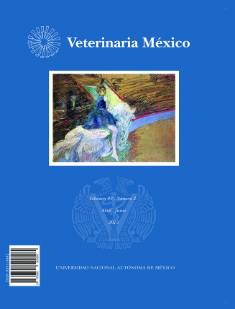Antimicrobial resistance in Mannheimia haemolytica strains isolated from dairy cattle nasal exudates
Main Article Content
Abstract
Two hundred and one strains of M. haemolytica isolated from nasal exudate of dairy cattle were used, 123 strains from clinically healthy (CH) bovines and 78 from clinically ill (CI) bovines affected by pneumonia, obtained from a dairy complex in the Tizayuca region of the state of Hidalgo, Mexico. Strains were previously identified by conventional culture and biochemical tests, and serotyped by indirect haemagglutination. Disk diffusion test was performed to determine antimicrobial resistance to antibiotics, such as: ampicillin, gentamicin, ceftiofiur, penicillin, streptomycin, trimethoprim-sulfamethoxazole, tetracycline and erythromycin. Frequencies of higher antimicrobial resistance were: streptomycin (81.6%) and gentamicin (24.4%), all strains were susceptible to ampicillin and penicillin. Because of the high resistant strain frequency (81.6%) of M. haemolytica to streptomycin, obtained by Kirby-Bauer test, presence of the strA gene, which encodes the enzyme aminoglycoside- 3-phosphotransferase that provides resistance to streptomycin, PCR was performed by testing the presence of the strA gene. Of the 201 strains tested, 42.7% showed the gene strA, 17.4% of which was serotype A1, 1.4% serotype A6 and 23.8% non-typeable strains. Of the 78 CI strains and 123 CH strains, 80% and 18.7%, had the gene strA, respectively.
Keywords:
Mannheimia haemolytica Resistance Antimicrobial Antibiogram Nasal exudate Cattle
Article Details
License

Veterinaria México OA by Facultad de Medicina Veterinaria y Zootecnia - Universidad Nacional Autónoma de México is licensed under a Creative Commons Attribution 4.0 International Licence.
Based on a work at http://www.revistas.unam.mx
- All articles in Veterinaria México OA re published under the Creative Commons Attribution 4.0 Unported (CC-BY 4.0). With this license, authors retain copyright but allow any user to share, copy, distribute, transmit, adapt and make commercial use of the work, without needing to provide additional permission as long as appropriate attribution is made to the original author or source.
- By using this license, all Veterinaria México OAarticles meet or exceed all funder and institutional requirements for being considered Open Access.
- Authors cannot use copyrighted material within their article unless that material has also been made available under a similarly liberal license.



